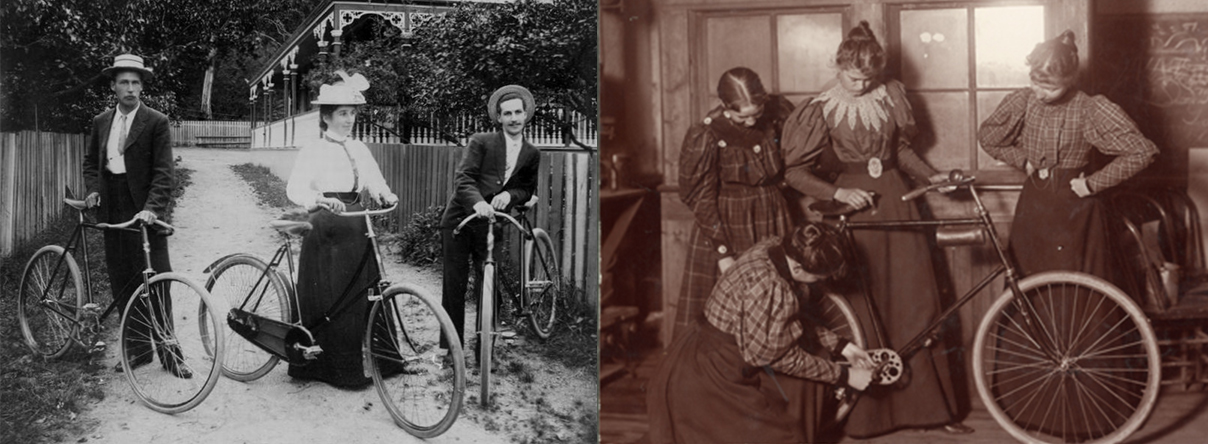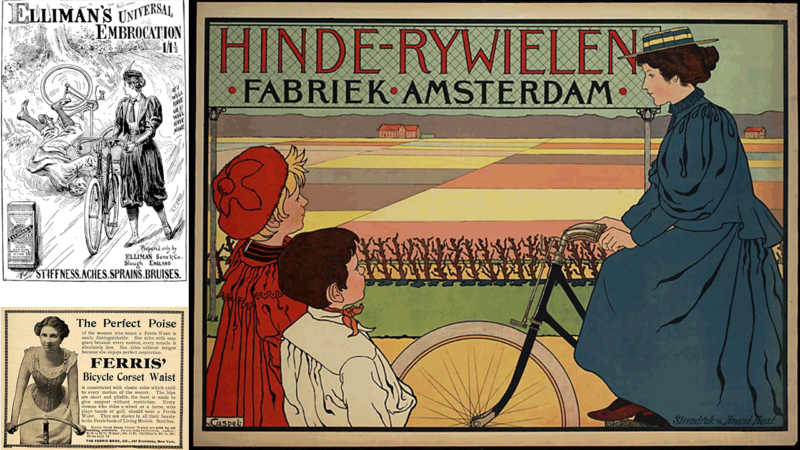The Freedom Machine
When the bicycle gained popularity during the late 1800s, women were still tangled up in the fashion of the day, making enjoyment of this new mode of transportation prohibitive. The push toward dress reform, also known as the rational dress movement, had been around since the mid-19th century. Once the bicycle became part of the national fabric in England and the United States, as well as other areas around the globe, there was no looking back for women who wanted freedom of movement, and not only in what they wore, in their everyday lives. Goodyear gives us this quote from Munsey’s Magazine in 1896 which sums it up very well:
“To men, the bicycle, in the beginning, was merely a new toy, another machine added to the long list of devices they knew in their work and play. To women, it was a steed upon which they rode into a new world.”

Right photo: Picture Collection, Library Montana State University-Bozeman
Transportation toward Emancipation
The first patent for a pedal bicycle was issued in 1866. Within three years, a ladies’ bicycle was patented and built in New York. The pedals for both were located on the front wheels, making it very easy for the dresses of the day to become entangled in the spokes. By the 1880s, the pedals were moved to where we see them today, but women were still challenged with petticoats and full skirts. Women wanted more freedom of movement; in their clothing and the ability to control more of their lives through travel.
Two things happened around this time. One was the invention of a tricycle that allowed women to enjoy bicycling without entanglement. The second was a change in fashion and what was acceptable for women to wear when cycling (and eventually beyond).
The introduction of the tricycle in the 1880s was a step toward change. The Rudge Rotary had two small wheels on the right side, one large wheel on the left, and allowed the rider to sit in the middle to peddle and steer. Other models featured the rider between two large wheels with the third wheel out in front or behind the rider. They were skirt-compatible and allowed women to ride for health and enjoyment. Women took to the tricycle in droves and pedaled thousands of miles.
Freedom in Fashion
Female corsets made for cycling and other athletic endeavors were seen starting in the 1890s. B. Godey’s Magazine from April 1896 featured several advertisements One by the W.B. Corset Company from touts such features as “cutaway hips, elastic gores, combining perfect freedom with shape and gracefulness… Designed for Athletic Purposes…” Ferris Brothers of New York offers the following: “… constructed with elastic sides which yield to every motion of the wearer. The hips are short and pliable, the bust is made to give support without restriction. Every woman who rides a wheel or a horse, who plays tennis or golf, should wear a Ferris Waist.” (Bisland)
Not only did undergarments change to meet the demand of the bicycling woman, outer clothing changed as well. Divided skirts and bloomers made riding safer and more comfortable. Some divided skirts came with detachable apron panels that covered up the pants. These garments were sold as cycling clothing. Norfolk and Eton jackets were very popular as part of the Victorian woman’s cycling attire.
Here are a few examples of Recollections ensembles that could be worn riding a bicycle. On the left is Lilith. The center photo is of Sienna. On the right is Hyacinth.

Credits
Bisland, Mary L. Woman’s Cycle. This Victorian Life. N.p., n.d. Web. 06 June 2016.
Goodyear, Sarah. How Women Rode the Bicycle into the Future [SLIDESHOW].Grist. N.p., 2011. Web. 01 June 2016.
Find out more about:
Victorian-inspired husband and wife cyclists
Victorian bicycling fashions














Leave A Comment